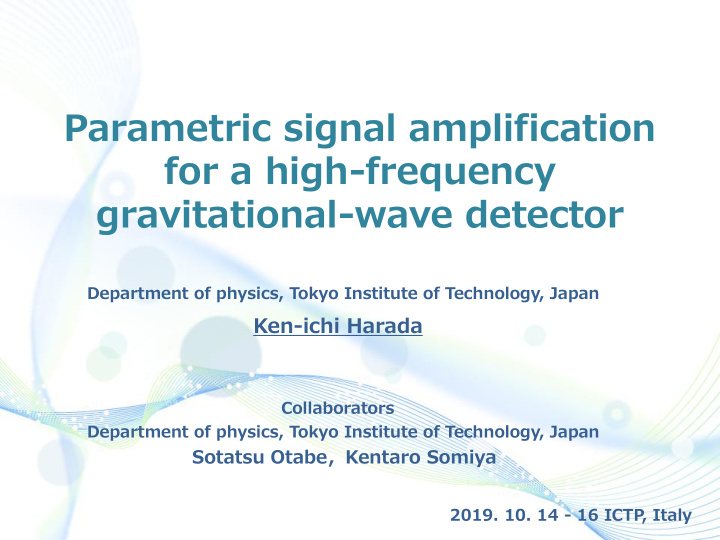



Parametric signal amplification for a high-frequency gravitational-wave detector Department of physics, Tokyo Institute of Technology, Japan Ken-ichi Harada Collaborators Department of physics, Tokyo Institute of Technology, Japan Sotatsu Otabe , Kentaro Somiya 2019. 10. 14 - 16 ICTP , Italy
Outline Introduction Optical spring Parametric signal amplification Experimental setup at Tokyo Tech. Result Summary 2
Gravitational Wave GW sources in a few kHz band binary neutron star merger, supernova, etc. Artist‘s illustration of the final stages of a neutron -star merger. The high-frequency signal cannot be detected by current GW detectors because of sensitivity degradation due to shot noise. D. Radice, et al., Astrophys. J. Lett. 842, L10 (2017). By improving the sensitivity in the kHz band, we significantly boost our understanding of the Universe. 3
Squeezer and amplifier For improving the detection sensitivity in a high-frequency band. Optical spring (OS) Beam splitter (BS) Laser Signal recycling Pump non-linear mirror (SRM) crystal Signal amplifier Pump Isolator SRM (detuned) Squeezed Photodetector vacuum Input squeezing Parametric amplifier - decreases noise - increases signal (wideband) (particular frequency) - weak against losses 4
Squeezer and amplifier For improving the detection sensitivity in a high-frequency band. Optical spring (OS) Optical spring (OS): Induced by interaction between electromagnetic radiation and mechanical motion. Suspended mirror Laser The mirror is pushed to the initial position by radiation pressure. Pump non-linear crystal Signal amplifier Initial position SRM (detuned) Parametric amplifier The mirror is moved - increases signal to the initial position by mechanical force. (particular frequency) Internal power of the cavity Position of the mirror 5
Parametric signal amplification Optical spring w/o OPA OS 𝐭𝐣𝐨 𝟑𝝔 𝛁 ∝ 𝒔 + 𝟐 𝒔 − 𝟑 𝐝𝐩𝐭 𝟑𝝔 Laser BS Optical spring with OPA Pump OPA s 𝐭𝐣𝐨 𝟑𝝔 SRM 𝛁 ∝ 𝒔 + 𝟐 𝒔 − 𝒕 + 𝟐 𝒕 𝐝𝐩𝐭 𝟑𝝔 𝒔 : reflectivity of SRM 𝝔 : detuned phase of SRM Optical spring frequency can be enhanced by tuning the optical parametric gain 𝒕 . 6
Sensitivity estimation Sensitivity of signal recycling Michelson interferometer (SRMI) with OPA 5 20 100 200 The peak of optical spring resonance When the optical parametric gain 𝐭 is large, the optical spring frequency become high. 7
How to do experiment Improvement of the detection sensitivity in HFB. It is tough to do... Confirmation of the signal amplification by measuring the resonance frequency of optical spring (OS). Experimental steps ⚫ Construction of MI and SRC ⚫ Construction of the stabilization system for MI and SRC ⚫ Generation of the pump laser (532 nm) by 2nd harmonic generation (SHG) ⚫ Confirmation of the OPA effect ⚫ Confirmation of the resonance frequency of OS 8
Experimental setup Laser output power Piezo1: Stabilize the MI system 1064 nm PBS Suspended mirror Diameter: 6 mm Weight: 0.2 g Resonant frequency: 16 Hz Mount made of polyester PBS: Polarizing beam splitter PD: Photodetector BS: Beam Splitter 9 Piezo: Piezoelectric Actuator
Experimental setup Laser output power Piezo1: Stabilize the MI system Piezo2: Stabilize SRC by using the subcarrier light Subcarrier: Modulated by AOM and EOM 1064 nm PBS Suspended mirror Diameter: 6 mm Weight: 0.2 g Resonant frequency: 16 Hz Mount made of polyester PBS: Polarizing beam splitter SRM: Signal recycling mirror PD: Photodetector BS: Beam Splitter 10 Piezo: Piezoelectric Actuator
Experimental setup Piezo1: Stabilize the MI system Piezo2: Stabilize SRC by using the sub-carrier light Bow-tie cavity: Generate 532 nm light by SHG Stabilized by the PDH method 1064 nm Cavity length: 1.2 m PBS f = 150 PPKTP PPKTP crystal: Temperature controlled by a oven PBS: Polarizing beam splitter SRM: Signal recycling mirror PD: Photodetector PPKTP: Periodically Poled KTiOPO 4 BS: Beam Splitter 11 Piezo: Piezoelectric Actuator PDH: Pound-Drever-Hall
Results Pump power (532 nm): 90 mW Measurement of the OS frequency Measurement of OPA Signal intensity (A.U.) Phase difference The Peak and shift of the OS Confirm the signal amplification frequency do not observed. of the 1064 nm light. We need the improvement for the setup. 12
Improvement of the setup Output power after the fiber amp. Fiber amplifier: Installed in the setup 1064 nm Output power of the pump Fiber amplifier Maximum output power: 10 W 532 nm power: achieved over 300 mW 13
Summary Parametric amplification of GW signal can be a way to improve the sensitivity at high frequencies. Confirmation of the signal amplification by measuring the resonance frequency of optical spring (OS). Introduce the fiber amplifier to increase the power. Confirm the output power of over 10 W. 1064 nm Confirm the output power of over 300 mW. 532 nm Future plan Confirmation of the resonance frequency of OS by using the improved powers. 14
Thank you for your attention! 15
Recommend
More recommend